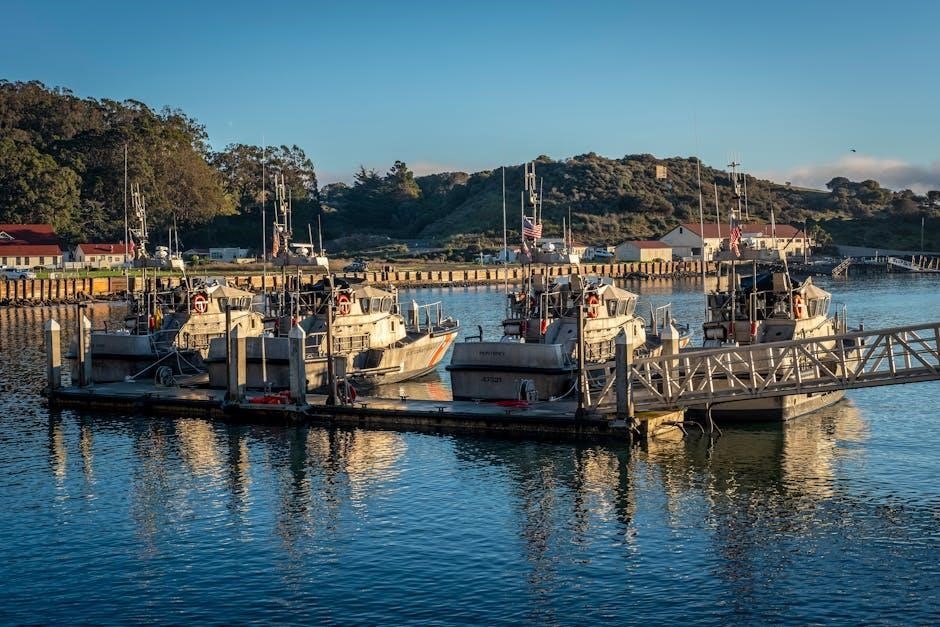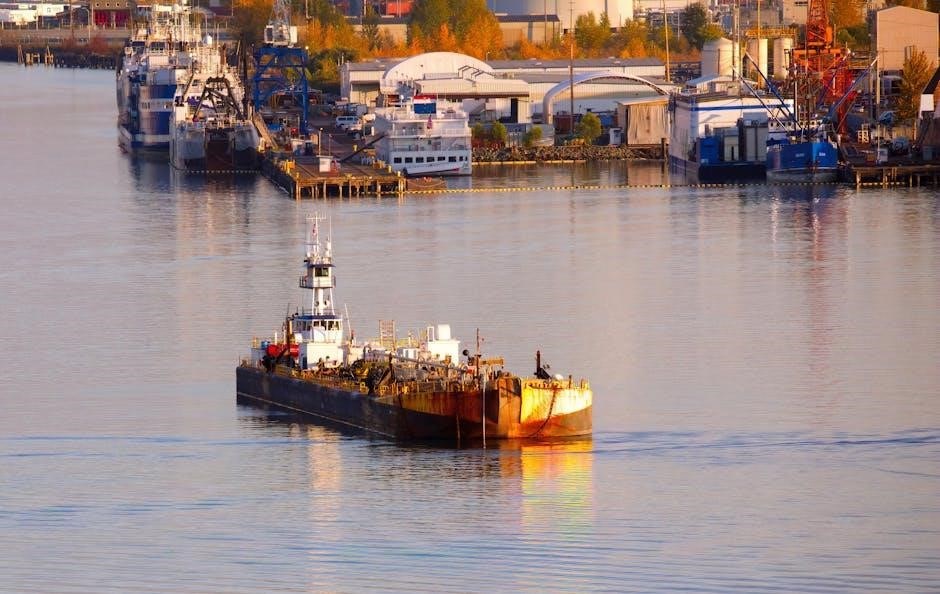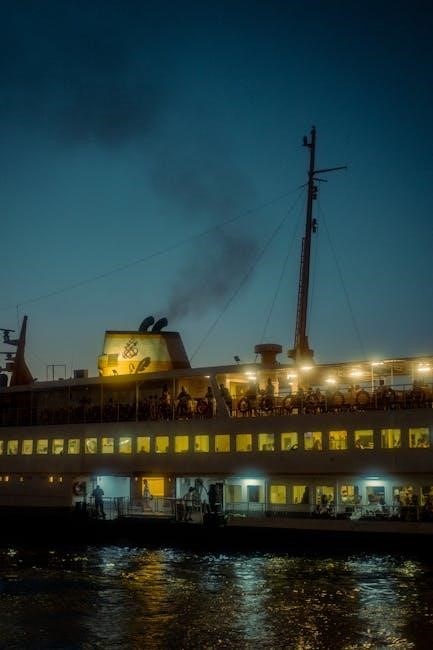navigation lights for ships pdf
Navigation lights for ships are crucial for safe navigation,
as per
various maritime regulations and standards, including those related to navigation lights for ships pdf downloads available online today always.
Importance of Navigation Lights
Navigation lights play a vital role in ensuring the safety of ships and their crew, as well as other vessels and marine traffic; According to various maritime regulations, navigation lights are a critical component of a ship’s navigation system, providing visual signals to other vessels and helping to prevent collisions. The importance of navigation lights cannot be overstated, as they are essential for safe navigation, particularly in low-visibility conditions such as at night or in poor weather. The use of navigation lights is mandated by international maritime law, and ships that fail to display proper navigation lights can be subject to penalties and fines. Furthermore, navigation lights are also important for communicating a ship’s status and intentions to other vessels, helping to prevent misunderstandings and reduce the risk of accidents. Overall, navigation lights are a crucial aspect of maritime safety and are essential for the safe operation of ships.

Types of Navigation Lights
Navigation lights include masthead, stern, and sidelights, with various types and configurations available for different ship sizes and
purposes
always used onboard ships today.
Masthead Lights
Masthead lights are a type of navigation light that is typically mounted on the mast or superstructure of a ship, and are used to indicate the ship’s direction and status; According to various maritime regulations, masthead lights must be visible from a certain distance and have a specific intensity and color. The installation of masthead lights is critical to ensure safe navigation, and they are usually designed to be compact and reliable. Power driven vessels less than 50m long may show only one masthead light, while power vessels less than 12m long may use a combined masthead and stern light. The use of masthead lights is an essential part of navigation systems, and they are widely used on professional boats and ships. Masthead lights are also available in LED versions, which offer high reliability and compact design, making them suitable for installation on ships of various sizes.
Stern Lights
Stern lights are a type of navigation light that is mounted at the rear of a ship, and are used to indicate the ship’s direction and status. The stern light is typically less intense than the masthead light, but is still an essential part of the navigation system. According to maritime regulations, stern lights must be visible from a certain distance and have a specific color and intensity. Power vessels less than 12m long may use a combined masthead and stern light, which simplifies the installation and maintenance process. The design of stern lights has evolved over time, with modern versions offering high reliability and compact design, making them suitable for installation on ships of various sizes. Stern lights are an important safety feature, and are widely used on professional boats and ships to prevent collisions and ensure safe navigation. They are also available in LED versions, which offer energy efficiency and long lifespan;

Installation and Maintenance
Proper installation and maintenance of navigation lights is crucial for safety, using
specific
guidelines and regulations to ensure correct functioning always online.
Installation Requirements
Navigation lights for ships have specific installation requirements, including the use of
correct
fixtures and mounting hardware to ensure proper visibility and durability. The installation process typically involves careful planning and execution to meet regulatory standards. A key aspect of installation is the selection of suitable locations for the navigation lights, taking into account factors such as visibility, obstruction, and electrical connectivity. Additionally, the installation must comply with relevant electrical and safety standards to prevent accidents and ensure reliable operation. The use of
reliable
and durable materials is also crucial to withstand the harsh marine environment and minimize maintenance needs. By following these installation requirements, shipowners and operators can ensure that their navigation lights function effectively and safely, reducing the risk of accidents and ensuring compliance with regulatory requirements. Proper installation is essential for safe navigation and communication at sea.
Reliability and Design
Navigation lights for ships are designed to be reliable and durable, with a focus on withstanding the harsh marine environment. The use of high-quality materials and
advanced
manufacturing techniques ensures that the lights can operate effectively in extreme conditions. A key aspect of reliability is the design of the light’s control systems, which must be able to withstand power fluctuations and other electrical disturbances. The design of the light’s optical system is also critical, with a focus on maximizing visibility and minimizing glare. By using
reliable
and durable components, navigation light manufacturers can provide products that meet the demanding needs of the marine industry. The design of navigation lights is continually evolving, with new technologies and materials being developed to improve reliability and performance. This ensures that ships can operate safely and efficiently, even in the most challenging conditions, with minimal downtime for maintenance.

Regulations and Standards
Maritime regulations and standards for navigation lights are outlined in various
documents
and guidelines available as navigation lights for ships pdf files online always.
IMO Regulations
The International Maritime Organization (IMO) sets regulations for navigation lights on ships, which are available in various documents and guidelines, including navigation lights for ships pdf files. These regulations outline the requirements for navigation lights, including their placement, intensity, and color. The IMO regulations are designed to ensure safe navigation and prevent collisions at sea. They apply to all ships, regardless of size or type, and are enforced by maritime authorities around the world. The regulations are regularly updated to reflect changes in technology and navigation practices. Ship owners and operators must comply with these regulations to ensure the safety of their vessels and crew. The IMO regulations are an essential resource for anyone involved in the maritime industry, and are widely available as navigation lights for ships pdf downloads. They provide detailed information on navigation light requirements and are used by maritime authorities to enforce safety standards.
Operator Requirements
Operators of ships have a responsibility to ensure that their vessels are equipped with proper navigation lights, as outlined in various guidelines and documents, including navigation lights for ships pdf files. These requirements include the use of navigation lights during periods of reduced visibility, such as at night or in foggy conditions. Operators must also ensure that their navigation lights are properly maintained and functioning correctly. This includes regular checks of the lights and replacement of any faulty or damaged components. Operators who fail to comply with these requirements may face penalties and fines. The operator requirements for navigation lights are designed to ensure the safe operation of ships and prevent accidents. They are an important part of maritime safety regulations and are enforced by authorities around the world. By following these requirements, operators can help to prevent collisions and ensure the safe navigation of their vessels.

Communication and Safety
Navigation lights enhance communication and safety at sea using
various
signals and codes always effectively today online;
Shapes and Flags
Shapes and flags are used by vessels to communicate with other vessels, as per various maritime regulations and standards, including those related to navigation lights for ships pdf downloads available online today.
The use of shapes and flags is an essential part of navigation and communication at sea, allowing vessels to convey important information about their identity, status, and intentions.
This information is critical for safe navigation and the prevention of collisions, and is used in conjunction with navigation lights to provide a complete picture of a vessel’s status.
The combination of shapes, flags, and navigation lights provides a robust and effective means of communication, allowing vessels to operate safely and efficiently in a variety of environments.
The use of shapes and flags is governed by a set of standardized rules and regulations, which are outlined in various maritime publications and resources, including navigation lights for ships pdf documents.
These resources provide detailed information on the use of shapes and flags, as well as navigation lights, and are an essential reference for mariners and other stakeholders.
Overall, the use of shapes and flags is a critical component of safe and effective navigation, and is used in conjunction with navigation lights to provide a complete and accurate picture of a vessel’s status.
Safety Considerations
Safety considerations are a top priority when it comes to navigation lights for ships, as outlined in various navigation lights for ships pdf documents.
The proper use and maintenance of navigation lights is critical to preventing collisions and ensuring the safe operation of vessels.
This includes ensuring that navigation lights are properly installed, maintained, and operated, as well as taking steps to prevent damage or malfunction.
Additionally, mariners must be aware of the various safety considerations related to navigation lights, including the potential for glare or obstruction.
The use of navigation lights in conjunction with other safety measures, such as radar and electronic charts, can help to reduce the risk of accidents and improve overall safety.
By taking a comprehensive approach to safety, mariners can help to ensure the safe and efficient operation of their vessels, and reduce the risk of accidents or injuries.
Overall, safety considerations are a critical component of navigation lights for ships, and must be carefully considered in order to ensure safe and effective operation.
